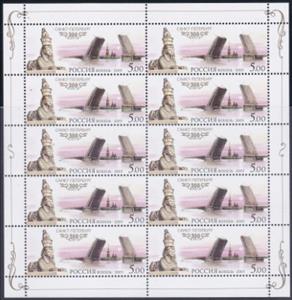Mini Sheet: A bridge across the Neva river with its parts opened (Russia 2003)
A bridge across the Neva river with its parts opened (Russia 2003)
15 May (Russia ) within release Jubilees of Cities (2003) goes into circulation Mini Sheet A bridge across the Neva river with its parts opened face value 10*5 Russian ruble
| Mini Sheet A bridge across the Neva river with its parts opened in catalogues | |
|---|---|
| Michel: | Mi: RU 1080KB |
Mini Sheet is vertical format.
Also in the issue Jubilees of Cities (2003):
- Mini Sheet - 300th Anniversary of St.-Petersburg. face value 10*5;
- Mini Sheet - The Spit of Vasilievsky Island face value 10*5;
- Mini Sheet - A bridge across the Neva river with its parts opened face value 10*5;
- Mini Sheet - The Palace Square face value 10*5;
- Mini Sheet - The Winter Palace face value 10*5;
Mini Sheet A bridge across the Neva river with its parts opened it reflects the thematic directions:
An anniversary is the date on which an event took place or an institution was founded in a previous year, and may also refer to the commemoration or celebration of that event. For example, the first event is the initial occurrence or, if planned, the inaugural of the event. One year later would be the first anniversary of that event. The word was first used for Catholic feasts to commemorate saints. Most countries celebrate national anniversaries, typically called national days. These could be the date of independence of the nation or the adoption of a new constitution or form of government. The important dates in a sitting monarch's reign may also be commemorated, an event often referred to as a "Jubilee".
Architecture (Latin architectura, from the Greek ἀρχιτέκτων arkhitekton "architect", from ἀρχι- "chief" and τέκτων "builder") is both the process and the product of planning, designing, and constructing buildings and other physical structures. Architectural works, in the material form of buildings, are often perceived as cultural symbols and as works of art. Historical civilizations are often identified with their surviving architectural achievements.
A bridge is a structure built to span physical obstacles without closing the way underneath such as a body of water, valley, or road, for the purpose of providing passage over the obstacle. There are many different designs that each serve a particular purpose and apply to different situations. Designs of bridges vary depending on the function of the bridge, the nature of the terrain where the bridge is constructed and anchored, the material used to make it, and the funds available to build it.
A monument is a type of structure that was explicitly created to commemorate a person or event, or which has become relevant to a social group as a part of their remembrance of historic times or cultural heritage, due to its artistic, historical, political, technical or architectural importance. Examples of monuments include statues, (war) memorials, historical buildings, archaeological sites, and cultural assets. If there is a public interest in its preservation, a monument can for example be listed as a UNESCO World Heritage Site. The Palgrave Encyclopedia of Cultural Heritage and Conflict gives the next definition of monument:
Myth is a genre of folklore consisting primarily of narratives that play a fundamental role in a society. For scholars, this is very different from the vernacular usage of the term "myth" that refers to a belief that is not true. Instead, the veracity of a myth is not a defining criterion





